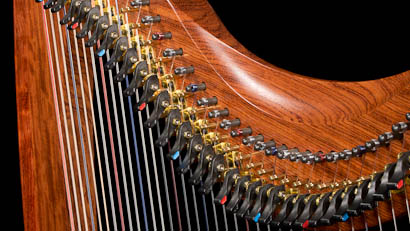
General Harp Information
Harps are probably the most ancient stringed instruments. Their beautiful sound and graceful aesthetic form have magically enticed man for many centuries. And even today, that fascination lives on.
A bit of history
In Ireland and Scotland, harps (in the form that we now know them) were first evident in the 9th Century A.D. These early harps were strung with metal strings, and the sound box was usually carved from a single log. They were a focal point of Celtic music, reaching their greatest use between 1000 and 1750 A.D. A bit later these small harps were strung with gut and played in the royal courts of Europe. Gradually, they evolved into the pedal harp used today in orchestras. Celtic or folk harps have recently made a resurgence in the music world. A wide variety of music is played on these instruments, including early, classical, folk, Renaissance, popular, and original music.
You can play!
At the Sylvia Woods Harp Center we help people of all ages fulfill their dreams of owning and playing one of these magical instruments. You, too, can learn to play the harp! No previous musical experience is necessary. Even as a beginner, the harp sounds pleasing; just running your hand over the strings creates lovely tones. And with the help of Sylvia Woods' book Teach Yourself To Play the Folk Harp, soon you can be playing beautiful music on your new harp.
Helpful videos
Sylvia has created a series of Informational Harp "How-To" Videos to help you learn about harps, and how they work. Subjects include: an introduction to harps, parts of the harp, basic tuning tips, and how to replace a broken string.
You'll find these useful videos in the Watch Our Videos section.
Lever Harps
 Lever harps (also called Celtic harps, non-pedal harps, folk harps, or Irish harps) are tuned diatonically: a "do re mi" scale, like the white notes on the piano. The strings are color-coded to help you find your way. Cs are red, and Fs are blue or black. Lever harps usually have sharping levers on each string which can be used to raise the pitch of the string one-half step, making a sharp.
Lever harps (also called Celtic harps, non-pedal harps, folk harps, or Irish harps) are tuned diatonically: a "do re mi" scale, like the white notes on the piano. The strings are color-coded to help you find your way. Cs are red, and Fs are blue or black. Lever harps usually have sharping levers on each string which can be used to raise the pitch of the string one-half step, making a sharp.
Here at the Sylvia Woods Harp Center we sell lever harps by two excellent harp makers:
Dusty Strings Harps in Seattle, Washington
and the Harpsicle Harp Company in Rising Sun, Indiana
Sharping Levers
The purpose of a sharping lever is to shorten the sounding length of a string on a lever harp, raising the pitch one half step, allowing you to play in different keys without re-tuning the harp. Our lever harps are available with a variety of levers. See each harpmaker's pages for their levers and prices.
Loveland levers have been the industry standard for several decades. Made of durable Delrin, the long handles move smoothly, and have a short throw which facilitates rapid lever changes. Tone quality is virtually unaltered with the lever engaged, and the sharping action maintains string alignment. Large red and blue dots on the C and F levers make them easy to find. Loveland levers come standard on Dusty Strings Harps. Adding our optional Color Rings to your C and F Loveland levers makes them even easier to see!

Camac levers are nickel-plated solid metal and have a smooth, quiet action. Tone quality is virtually unaltered with the lever engaged, and the sharping action maintains string alignment. Tear drop shaped levers allow for comfort and easy grip. C and F lever handles are clearly designated in metallic red and blue, making them extremely easy to see. Camac levers are optional on some Dusty Strings models.

Rees levers are installed on all of the Harpsicle Harp Company harps. They are of solid brass with a durable non-tarnish, nickel plating. The strong handles are comfortable with a smooth action. These levers have a lifetime warranty.

Pedal Harps
As of August 2010, we are no longer selling pedal harps. Please contact these harp makers directly:
Lyon & Healy Harps
Salvi Harps
Click the arrow to hear Sylvia Woods explaining how pedal harps work.
